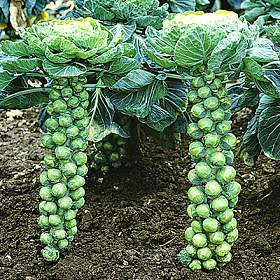Growing Brussels Sprouts
Organic Vegetable Gardening
Fact Sheet
Botanical name: Brassica oleracea gemmifera
Seed |
|
||
| Planting time: | SP,FA | ||
| Seeds per ounce: | 9000 | ||
| Ounces per square foot: | 0.0001 | ||
| Minimum legal germination rate: | 70% | ||
| Germination type: | |||
Notes The "sprouts" that resemble miniature cabbages, grow in the leaf axils, starting at the base of the stem and working upward. The sprouts will improve in quality and will grow best in cool or even lightly frosty weather. HarvestingMost open pollinated varieties of Brussels Sprouts are harvested at intervals over a period from the bottom to the top as the sprouts mature. This is better for a family for a continuous harvest; instead of the newer hybrids, which mature more uniformly with more sprouts all at once. Optional: When Growing Brussels Sprout pinch out terminal buds (the buds at the top of the plant) to encourages rapid sprout development along the stem, particularly the upper sprouts - although this action will reduce the total yield. Harvest sprouts from the bottom of the stem to the top as they reach about 1" in diameter. Sprouts left on the plant too long become tough and lose flavor. Brussels Sprouts will produce seed the second year. |
|||
Planting |
|||
| In garden spacing (inches): | 15 | ||
| In flat spacing (inches): | 1 | ||
| Planting depth (inches): | cover seed with soil | ||
| Maximum number of plants per square foot: | .5 | ||
| Nutrient relationship: | Heavy Feeder | ||
Harvest |
|||
| Days to maturity: | 77-91 | ||
| Harvesting period (days): | 84 | ||
| Minimum yields in pounds /square foot: | .70 | ||
Cultural |
||
| Diseases: | Pythium Damping-Off - This disease commonly affects seeds and young transplants and is caused by the soil-borne fungus. Downy Mildew - This disease is caused by the fungus Peronospora parasitica and can attack both seedlings and mature vegetable plants. Alternaria Leaf Spot - This disease is caused by the fungus, Alternaria species, and occurs during warm, moist conditions. Black Rot - Black rot is caused by a bacterium, Xanthomonas campestris pathovar campestris, and can affect all vegetables in the crucifer family. Black Leg - The fungus, Phoma lingam, causes black leg. Wirestem - The fungus, Rhizoctonia solani, causes wirestem. Fusarium Yellows - Yellows or wilt is a much less important disease today due to the development of varieties resistant to the disease. Viruses - There are several common viruses that can affect cole crops including Turnip mosaic virus and Cauliflower mosaic virus. |
|
| Insect pests:(Insect Pest Finder) | Army Cutworm, Bean Aphid, Cabbage Curculio, Cabbage Looper, Cabbage Maggot, Cutworm, Flea Beetle, Garden Centipede, Green Peach Aphid, Pea Aphid, Spotted Cucumber Beetle | |
Varieties for Growing Brussels Sprouts |
||
| 'Genius' - a late season variety. | ||
| 'Jade Cross' - an old variety with slightly bitter taste | ||
| 'Oliver' - an early season variety. Medium green. Mild taste. | ||
| 'Rampart' - a late season variety. | ||
| 'Long Island Improves' - an old variety and is harder to produce heavy, uniform crop. | ||
| 'Rubine' - red plants and sprouts. Late maturing. | ||
Organic Gardening Seed and Plant Sources:
Return to Organic Gardening Vegetables from Growing Brussels Sprouts




Comments
Have your say about what you just read! Leave me a comment in the box below.